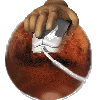| Past Distributed Computing Projects |
| Many of the links on this page may no longer work. They are kept here for historical purposes. |
| Project Information | Category | Completion Date | Project Duration | Total Number of Participants / Computers | ||||
|---|---|---|---|---|---|---|---|---|
United Devices Anthrax project. More information about this project will
be posted soon.
|
Life Sciences | |||||||
| United Devices Web Performance Testing project. More information about this project will be posted soon. | Internet | |||||||
| Genetic Research with HMMER. More information about this project will be posted soon. | Life Sciences | |||||||
| the smallest remaining Sierpinski problem candidate k=4847 project searched for prime numbers of the form 4847.2n+1 for n > 1,000,000 (n <= 1,000,000 had already been checked). The project was coordinated by Payam Samidoost, an active researcher of Fermat numbers. It used George Woltman's PRP software. The project was merged with the Seventeen or Bust project in November, 2002. | Mathematics | November, 2002 | 4 months | 9/unknown | ||||
|
After 68,228,567 total distinguished points were found, the solution was discovered to be k=281183840311601949668207954530684. See more information about the solution. Join a discussion group about this project. |
Cryptography | October 15, 2002 | 6 months | 10,308/unknown | ||||
| The dual Sierpinski problem search tried to find a prime in each sequence of integers of the form k + 2n (fixed k) for which no prime had yet been found. The project was coordinated by Payam Samidoost, an active researcher of Fermat numbers. The project used George Woltman's PRP software (available for Windows and Linux). | Mathematics | October, 2002 | unknown | unknown/unknown | ||||
 Care2's Race for the Pandas
had a
free button for people to click to save 0.3 acres (2.2 square meters) of
endangered panda habitat per click. The project generated 4,185,000 donations,
which saved about 1.2 million acres (about 486,000 hectares) of habitat
in the Wanglang Nature Reserve in China.
Care2's Race for the Pandas
had a
free button for people to click to save 0.3 acres (2.2 square meters) of
endangered panda habitat per click. The project generated 4,185,000 donations,
which saved about 1.2 million acres (about 486,000 hectares) of habitat
in the Wanglang Nature Reserve in China.
|
Charity | July 22, 2002 | 458 days | over 600,000/unknown | ||||
| Give Water, sponsored by Thames Water, gives safe drinking water to needy people around the world. The project had a free donation button that it asked to be clicked 4 million times. After that goal was reached, the project donated £200,000 to Water Aid, enough money to provide safe drinking water for 13,000 people. Note that the original goal of the project was to donate £50,000 to help 4,600 people. | Charity | June 26, 2002 | 6 months | unknown/unknown | ||||
|
The website is written in French, but an English translation of the main page is available, and babelfish provides a reasonable translation of the text. More information in English may be found at AFM, Association Francaise contre les Myopathies. |
Life Sciences | May 2, 2002 | 2 months | 75,000/unknown | ||||
| The pi(x) Table Project constructed a very large table of values of pi(x) for large values of x. The table would allow people to study the behavior of the pi(x) function in large ranges, a study which had never before been possible. The project also looked for the first known change of sign of the function pi(x)-Li(x). The first phase of the project computed pi(x) for 1.e16 < x < 1.e17. The last phase computed pi(x) for 1.e17 < x < 1.e18. | Mathematics | May, 2002 | 1 month | unknown/unknown | ||||
| The pi(x) project calculated pi(x), for very large values of x, up to x=4*1022. It began, but did not end, calculations for for x=1023. | Mathematics | April 15, 2002 | 17 months | unknown/unknown | ||||
 Stephen Brooks'
Distributed
Particle Accelerator Design project designed "a channel of magnets to
produce a particle beam of muons as efficiently as possible from a source of
pions spreading in almost all directions. The pions decay into muons and
change direction as they move through the apparatus, making this a particularly
challenging problem." Before the project, the highest efficiency was 2.9%:
the project achieved an efficiency of almost 7.1%. Version 3 of the client
application used a genetic algorithm to improve its design and to learn from
previous records in the results file, so it found more efficient designs even
faster.
Stephen Brooks'
Distributed
Particle Accelerator Design project designed "a channel of magnets to
produce a particle beam of muons as efficiently as possible from a source of
pions spreading in almost all directions. The pions decay into muons and
change direction as they move through the apparatus, making this a particularly
challenging problem." Before the project, the highest efficiency was 2.9%:
the project achieved an efficiency of almost 7.1%. Version 3 of the client
application used a genetic algorithm to improve its design and to learn from
previous records in the results file, so it found more efficient designs even
faster.
|
Science | March 1, 2002 | 7 months | 148/unknown (7.066% best muon transfer rate for 6,373,866,047 total particles simulated) | ||||
 qoopy uses a single
infrastructure to support many kinds of client applications (similar to the
Parabon Computation project. The
site is hosted by the University of
Dortmund in Germany and is written in German, but an
English version is also available.
qoopy uses a single
infrastructure to support many kinds of client applications (similar to the
Parabon Computation project. The
site is hosted by the University of
Dortmund in Germany and is written in German, but an
English version is also available.
qoopy's first project, EvoChess, evolved chess-playing programs. Each user's client generated some programs. The more successful programs survives and combines with other users' chess programs to speed up the evolutionary process. Users could play against the evolved chess programs and see information about the best evolved programs in the stats pages. The last version of the project client only allowed programs which looked ahead 5-10 moves to survive. In the end, "the first evolution converged quite fast. This was due to the fact that the individuals faced an immovable enemy (the minimax algorithm)." A diploma thesis "Verteilte Evolution von Schachprogrammen" (Distributed Evolution of Chess Programs) based on this project and written by Roderich Groß and Keno Albrecht, is available online (it is available only in German). |
Puzzles/Games | February 23, 2002 | 6 months | 1,700 users/unknown (2,228,343 games played) | ||||
 grid.org ran
health, science, and Internet-related research projects.
grid.org ran
health, science, and Internet-related research projects.
grid.org's first completed project was a bioinformatics research project for the Washington University in St. Louis, Missouri. The project, called HMMER, used the Hidden Markov Modeling technique to compare known DNA sequences (amino acids) against the data from the Human Genome Project to find similar sequences. grid.org's second completed project searched for potential drugs to fight the toxic properties of anthrax so that the disease can be treated in humans in its advanced stages. Any likely drug candidates from the project will be given to the U.S. government and other U.S.-friendly governments for further development into actual drugs. This project began on January 22, 2002 and the screening phase concluded successfully on February 14, 2002. From a pool of 3.57 billion molecules it found over 300,000 drug candidates. |
Life Sciences | February 14, 2002 | 4 weeks | unknown/unknown (2,867,618 results) | ||||
|
The Safer Markets URL is redirected to entropia's home page, and the SaferMarkets was taken offline immediately when the project concluded. |
Financial | January, 2002 | 9 months | unknown/9,335 (970,885 tasks completed) | ||||
 DataSynapse built
a better P2P web searcher by joining with the National Center for
Supercomputing Applications (NCSA) and Lehigh University to develop an
approach called Hierarchical Distributed Dynamic Indexing (HDDI TM).
Participants were entered into prize sweepstakes drawings. The project was
designed only for users with broadband Internet connections and was only
available for the Windows platform.
DataSynapse built
a better P2P web searcher by joining with the National Center for
Supercomputing Applications (NCSA) and Lehigh University to develop an
approach called Hierarchical Distributed Dynamic Indexing (HDDI TM).
Participants were entered into prize sweepstakes drawings. The project was
designed only for users with broadband Internet connections and was only
available for the Windows platform.
|
Internet | December 17, 2001 | less than 1 year | over 10,000/unknown | ||||
|
|
Mathematics | November 11, 2001 | unknown | 11/unknown | ||||
 The
GOLEM@Home
Project designed and evolved robotic lifeforms via a screensaver application.
The screensaver randomly created a population of virtual robots on users'
systems and then evolved them (the rule for evolution was survival of the
robots who could move the greatest distance over an infinite plain). Every
week or so a few of a user's robots moved to someone else's Golem screensaver
and a few of someone else's robots moved to the user's screensaver (this
feature could be disabled for users worried about security). The virtual
robots contained design information that could be used to build actual
working robots.
The
GOLEM@Home
Project designed and evolved robotic lifeforms via a screensaver application.
The screensaver randomly created a population of virtual robots on users'
systems and then evolved them (the rule for evolution was survival of the
robots who could move the greatest distance over an infinite plain). Every
week or so a few of a user's robots moved to someone else's Golem screensaver
and a few of someone else's robots moved to the user's screensaver (this
feature could be disabled for users worried about security). The virtual
robots contained design information that could be used to build actual
working robots.
|
Science | October, 2001 | 1 year | 30,000 | ||||
 Folderol was
a volunteer project that used a screensaver, command-line client or system
client application to simulate
protein folding
of the data from the Human Genome
Project. The project completed 36 years of simulation before the project
coordinators placed it on hold indefinitely. They may restart it if and
when they have time to support it again.
Folderol was
a volunteer project that used a screensaver, command-line client or system
client application to simulate
protein folding
of the data from the Human Genome
Project. The project completed 36 years of simulation before the project
coordinators placed it on hold indefinitely. They may restart it if and
when they have time to support it again.
|
Life Sciences | September 27, 2001 | less than 1 year | unknown/unknown | ||||
 Popular Power searched for a more effective influenza vaccine. The company went out of
business
on March 17, 2001, but the founders continued the influenza vaccine project
until September, 2001. The client used Java for task implementation to
provide a secure "sandbox" area within which its customers could run their own
code without being able to acces the rest of your system (the way a browser
provides a secure area for a Java applet).
Popular Power searched for a more effective influenza vaccine. The company went out of
business
on March 17, 2001, but the founders continued the influenza vaccine project
until September, 2001. The client used Java for task implementation to
provide a secure "sandbox" area within which its customers could run their own
code without being able to acces the rest of your system (the way a browser
provides a secure area for a Java applet).Background of the influenza vaccine modeling project. The last unofficial Stats Page created by Mike Rosack. |
Life Sciences | September, 2001 | 14 months | unknown/unknown | ||||
 The NASA
Clickworkers Study
asked volunteers to mark and classify craters on images of Mars. The
project presented images in temporary web pages. Volunteers used Java
software to mark the locations and sizes of craters in the images. The pilot
project concluded in June, 2001. As of December 31, 2000, 65,991 craters were
marked and 17,233 craters were classified.
The NASA
Clickworkers Study
asked volunteers to mark and classify craters on images of Mars. The
project presented images in temporary web pages. Volunteers used Java
software to mark the locations and sizes of craters in the images. The pilot
project concluded in June, 2001. As of December 31, 2000, 65,991 craters were
marked and 17,233 craters were classified.
The project also provided some other activities for fun:
|
Distributed Human Project | June, 2001 | unknown | unknown/unknown | ||||
| The perceive.net cloudmakers project attempted to solve a puzzle called RUR-14 (the puzzle is described at the cloudmakers website: this puzzle is connected to the Kubrick/Spielberg movie A.I.) This project used Windows console application or Perl client to solve the puzzle using a brute-force technique, submitting each possible key to the puzzle website. It tested 0.81576% of the total number of keys before the puzzle was solved by a person independent of the project. More information about the project can be found in a Slashdot article. | Games/Puzzles | May 30, 2001 | 8 days | 321/unknown | ||||
| DCypher.net was designed to run multiple and different types of projects. It ran a CSC decryption contest and a project to design safer storage vessels for nuclear waste. For the gamma flux project it processed almost 100 million work units. DCypher.net was the first project to use weekly cash giveaways to encourage participation. The project's parent company, Distributed Science, went out of business on May 24, 2001. The project shut down soon afterward. | Cryptography | May, 2001 | 1 year | unknown | ||||
|
Internet | May, 2001 | 4 months | unknown | ||||
|
The site is in German, but you can use a free machine translator to see reasonable translations of the site's pages. |
Science | March 31, 2001 | 12 months | 8432/unknown (1.2 million CPU hours) | ||||
 PiHex
caluclated the quadrillionth digit of Pi (which is
0). The creator of the PiHex project will soon begin more complex projects
at idlepower.net.
PiHex
caluclated the quadrillionth digit of Pi (which is
0). The creator of the PiHex project will soon begin more complex projects
at idlepower.net.
|
Mathematics | September 11, 2000 | 24 months | 1246/1734 (1.2 million CPU hours) | ||||
| The ECC2K-108 project solved Certicom's ECC2k-108 Elliptic Curve Discrete Logarithm challenge. | Mathematics | April 4, 2000 | 4 months | 1300/9500 | ||||
| The Internet Animation '99
"was an experimental project aimed to discover how a computer 3D animation
could have been done using people from all over the world and coordinating
everything using only email and a web page." You can
download the movie from ifilm.
This site has a Lessons Learned page and other information for people who want to start their own animation collaboration projects. |
Art | August, 1999 | 2 years | unknown | ||||
| Swiss Knife Software had a screen saver application which tried to solve the Eternity puzzle. | Puzzles/Games | stopped in July, 1999; not completed | unknown | not applicable | ||||
| Golomb Rulers - The Search For 20 and 21!, the first Internet-based distributed project to find optimal golomb rulers (OGRs). The project found OGRs for 20, 21, 22, and 23 marks. The project tested 628 trillion nodes for the 22-mark ruler and 398 trillion nodes for the 23-mark ruler. The OGR search is continuing at distributed.net. | Mathematics | May, 1999 | 2.5 years | unknown | ||||
| Distributed Genetic Programming on the Internet used genetic programming in a Java applet to navigate artificial ants along the Santa Fe trail.
The website was removed in October, 2000. The project had some interesting graphics. |
Puzzles/Games | mid 1998 | unknown | unknown | ||||
| The Cyberian RC5-56 Challenge used a brute force attack to try to decrypt a message encrypted with the RC5 algorithm, for a contest organized by RSA Security, Inc.. About 10,000 computers around the world participated in the effort. Source code for the project is available for download. | Cryptography | 1998 | 2 years | unknown/10,000 | ||||
| The RSA Factoring-By-Web project was "the first large scale project that makes use of a new and faster factoring method: the Number Field Sieve (NFS). Our first goal [was] to factor a 130-digit number (known as RSA-130, part of the RSA-factoring challenge). After that we [went] for bigger numbers, with the ultimate goal to evaluate how hard it would be to break a 155-digit number." The project factored RSA-130 on April 10, 1996. | Cryptography | 1996 | 1 year | unknowl/unknown |
| Top... |